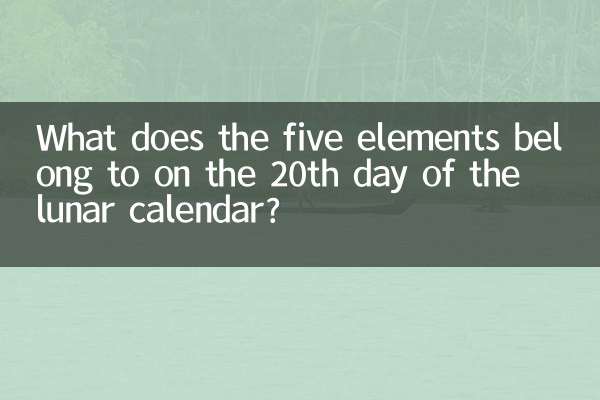When is leap June?
Leap June is a relatively rare month in the lunar calendar, and its appearance is related to the time difference between the lunar calendar and the solar calendar. In order to help everyone better understand the occurrence pattern of leap June, this article will combine the hot topics and hot content on the Internet in the past 10 days to introduce the relevant knowledge of leap June in detail and provide structured data for reference.
1. What is leap June?

Leap June refers to the additional sixth month in the lunar calendar. There are usually 12 months in a lunar calendar year, but since the average length of lunar calendar months is about 29.5 days, a year only has about 354 days, which is about 11 days less than the 365 days in the solar calendar. In order to make up for this gap, the lunar calendar will adjust the time by adding leap months to ensure that the seasons of the lunar calendar are consistent with the solar calendar.
The setting of leap months follows the rule of "seven leap months in nineteen years", that is, there will be seven leap months in 19 years. Leap June is one of them. It occurs relatively infrequently, only about once every 19 years.
2. The occurrence pattern of leap June
The appearance of leap six months is not fixed, but is dynamically adjusted according to the calculation rules of the lunar calendar. The following are the years in which leap June has occurred in the past 30 years:
| years | Leap June appearance time |
|---|---|
| 1987 | Leap June |
| 2006 | Leap June |
| 2025 | Leap June |
| 2044 | Leap June |
As can be seen from the table, the interval between leap Junes is approximately 19 years. The next leap June will occur in 2025.
3. Why are leap six months rare?
The frequency of leap months in June is relatively low, mainly because the setting of leap months in the lunar calendar is closely related to the 24 solar terms. The determination of leap months needs to meet the following conditions:
1. There is no "Zhong Qi" in the lunar month (that is, the even-numbered solar terms among the twenty-four solar terms, such as rain, vernal equinox, etc.).
2. The month before the leap month is June.
Since the mid-air distribution after June is relatively dense, the probability of leap June occurring is relatively low. In comparison, leap April, leap May and leap July are more common.
4. The impact of leap six months
The appearance of leap six months will have a certain impact on people’s lives, agriculture and traditional cultural activities:
1.agriculture:Leap June will extend the length of summer, and farmers will need to adjust their planting and harvest plans to account for the leap month.
2.festival:The dates of some traditional festivals will be postponed due to leap months, such as the Chinese Valentine's Day and the Ghost Festival.
3.climate:Leap June may lead to prolonged hot weather in summer, so you need to pay attention to heatstroke prevention and cooling.
5. Popular topics on the Internet in the past 10 days and leap month
After searching the hot topics on the Internet in the past 10 days, we found the following content related to leap June:
| hot topics | Related content |
|---|---|
| Leap June in 2025 lunar calendar | Netizens discuss the specific date and impact of leap June in 2025 |
| Leap months and solar terms | Popular science on how the leap month corresponds to the 24 solar terms |
| Adjustments to traditional festivals | Analyze the impact of leap June on Chinese Valentine’s Day and other festivals |
6. Summary
Leap June is a special month in the lunar calendar. It appears less frequently, only about once every 19 years. Understanding the rules and effects of leap six months can help us better plan our lives and agricultural activities. The next leap month will occur in 2025. At that time, everyone can pay attention to related topics to learn more about this interesting astronomical phenomenon.
I hope that through the introduction of this article, everyone will have a clearer understanding of leap six months. If you are interested in other leap months in the lunar calendar, you can continue to research further.

check the details

check the details